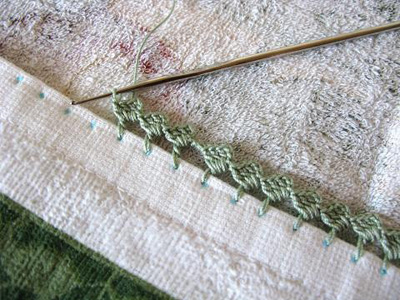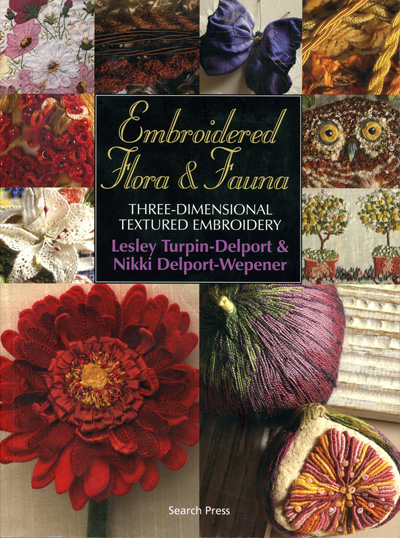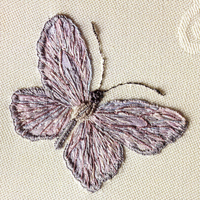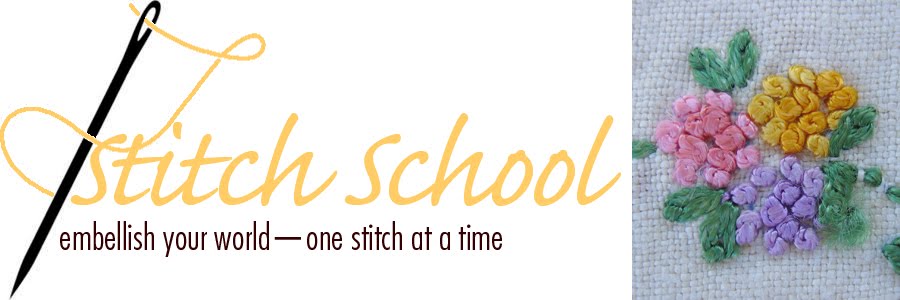skip to main |
skip to sidebar
 I have several stamped-for-embroidery pillowcases that already have the holes along the edge for attaching crochet. I just never knew how to go about attaching it. Well, I sort of knew but, having never crocheted before and finding most instructions daunting, I've never even tried.
I have several stamped-for-embroidery pillowcases that already have the holes along the edge for attaching crochet. I just never knew how to go about attaching it. Well, I sort of knew but, having never crocheted before and finding most instructions daunting, I've never even tried.
But, there may be hope for me yet. Kathleen Mower, on her blog Miss Abigail's Hope Chest, has a tutorial for an easy zig-zag crocheted edging that might be the perfect thing to finish my project. Perhaps yours, too. She added hers to a towel (and it took just 30 minutes!), but it should work equally well for pillowcases. If you want to try this, she suggests skipping over some of the holes, choosing ones that are spaced about 3/8-inch apart; otherwise there won't be enough room for the little diamond shapes.
 This lovely book was first published in 2007 in South Africa, again in Great Britain in 2008, and reprinted twice more in 2009. Which tells you something of it's popularity with lovers of needlework. And the projects are simply stunning. You'll get plenty of basics as to techniques and materials, too, but it's probably not for the beginning embroiderer. Think of it as a next step when you feel the need to add some dimension and texture to your work.
This lovely book was first published in 2007 in South Africa, again in Great Britain in 2008, and reprinted twice more in 2009. Which tells you something of it's popularity with lovers of needlework. And the projects are simply stunning. You'll get plenty of basics as to techniques and materials, too, but it's probably not for the beginning embroiderer. Think of it as a next step when you feel the need to add some dimension and texture to your work.
 And three-dimension and texture are what this book is all about. Techniques include fabric manipulation, wire-edged applique, barbola (unwired stumpwork), needle lace on wire, trapunto quilting, working with felt and ribbon, beading, and metallic threads. Used together as mixed media, which you'll see in the projects that follow, they provide endless ways of creating realistic flora and fauna.
And three-dimension and texture are what this book is all about. Techniques include fabric manipulation, wire-edged applique, barbola (unwired stumpwork), needle lace on wire, trapunto quilting, working with felt and ribbon, beading, and metallic threads. Used together as mixed media, which you'll see in the projects that follow, they provide endless ways of creating realistic flora and fauna.
 The projects, which are all inspired by the natural world, are categorized by color inspiration. Red, for example, features projects for three-dimensional felt gerbera daisies and wired applique bougainvilla; green has a nesting weaver bird incorporating actual feathers and a praying mantis that uses organza ribbon for his transparent wing. There are flowers, butterflies, insects, and birds and even a project for a realistic fig made from felt, yarn and beads (see the book cover for a close-up of this). All projects are illustrated with gorgeous photos of the finished piece and many have close-up views as well so you can really see the fine detail.
The projects, which are all inspired by the natural world, are categorized by color inspiration. Red, for example, features projects for three-dimensional felt gerbera daisies and wired applique bougainvilla; green has a nesting weaver bird incorporating actual feathers and a praying mantis that uses organza ribbon for his transparent wing. There are flowers, butterflies, insects, and birds and even a project for a realistic fig made from felt, yarn and beads (see the book cover for a close-up of this). All projects are illustrated with gorgeous photos of the finished piece and many have close-up views as well so you can really see the fine detail.
The book finishes with a section of black-and-white stitch diagrams and patterns for the projects that require them.
I found my copy at my local fabric store but it's also available on Amazon (and if you want to purchase a copy, please click through the link included above).









